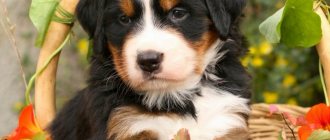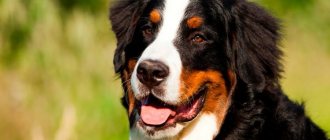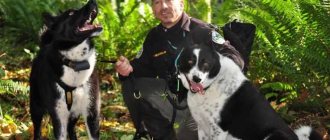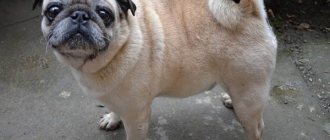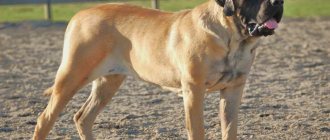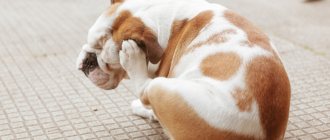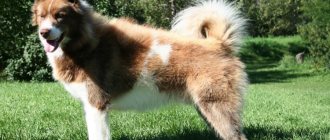/ Dogs / Dog breeds / Bernese Mountain Dog breed
0
2795
Article rating
The Bernese Mountain Dog is a large, long-haired dog that is beautiful, calm and friendly. Outwardly, it is similar to representatives of such breeds as Newfoundland and St. Bernard. Moreover, the similarity here is not only external, but also in terms of character and intelligence. These are gentle, pleasant animals, moderately docile and intelligent. For these qualities they are valued by both professional dog breeders and novice dog lovers. The only job for which the Bernese Shepherd is not suitable is hunting, since this dog does not have the necessary instincts.
Bernese Mountain Dog
Characteristics of the Bernese Mountain Dog breed
The description of the Bernese Mountain Dog breed should begin with a short excursion into history. She was bred on the territory of modern Switzerland as an assistant to shepherds. These dogs have common ancestors with the St. Bernard, only the St. Bernard was used as a rescue dog, and the Bernese Shepherd herded herds, so even then it turned out to be a very good guard. Then, when in the twentieth century, dog handlers began purposefully breeding these animals, they were crossed with divers. Soon after this, the breed began to look as it does today.
Appearance and body type of the Bernese Mountain Dog
This breed is distinguished by its large and massive, but at the same time harmonious physique. They have an elongated body with a developed and wide chest, without a pronounced transition from the abdomen to the chest. The average height at the withers of a representative of this breed is 0.67 m, and the weight is 45 kg. At the same time, males are 2-4 cm taller than females and exceed them in weight by 2-3 kg. The limbs of these pets are strong and muscular, with powerful and compact paws adapted for long running. The tail is long, not docked, sometimes its end curls into a ring, reaching the hock joints.
The head of the Bernese Mountain Dog is large, with a wide and rounded skull, powerful jaws and developed brow ridges. The forehead is relatively wide, there is a sharp, pronounced transition from the forehead to the nose. The jaws are powerful, with strong muscles, a full set of teeth and a regular, scissor bite. The ears are hanging, set high, they have a triangular shape and rounded ends. Nose with wide nostrils, exclusively black. The pupil of the eye is dark in color, black or dark brown, with the whites of the eyes visible. The look is smart and calm.
Color and texture of the Bernese Mountain Dog's coat
According to the standard, Swiss Cattle Dogs, as Bernese Mountain Dogs are also called, are long-haired animals. They have a thick, straight or somewhat wavy coat with a dense undercoat. The main hair is relatively coarse, while the undercoat is soft and silky, pleasant to the touch. On the chest and tail the fur is somewhat longer and thicker than on the rest of the body. And on the muzzle and forehead the hair is short and smooth.
In terms of color, the Bernese Mountain Dog breed standard is strict and provides only one option. According to the description, this is a tri-colored dog. The main coat color is black without admixtures of other colors. The reddish tan markings stand out sharply on it, which are located on the eyebrows, on the cheeks, on the chest and on all four limbs. There must also be a white mark on the muzzle and a white mark on the chest and neck. It is desirable that the paws are also white, but it should not rise at the pasterns. It is appreciated if the dog has a white tail tip, but this is not a requirement. All other color options are undesirable.
Appearance and character
The breed description emphasizes that the animals are suitable for heavy work. In particular, Mountain Dogs are traditionally considered sled dogs. The need to drag large loads (up to 500 kg) over long distances has left its mark on the appearance of Bernese Mountain Dogs. They are characterized by a massive body with well-developed muscles.
In accordance with the breed standard, the parameters of adult shepherd dogs are:
- in males - weight 38-50 kg, height 61-71 cm;
- in females - weight 36-48 kg, height 58-69 cm.
Visually, boys are larger than girls. Animals reach their optimal size gradually as they grow older. At one month of age, puppies weigh 2.5-4.5 kg, at six months - 25-38 kg, per year - from 30 to 50 kg. Detailed information is presented in the table.
Puppy weight by month (in kg):
| Month | Maximum | Average | Minimum |
| 1 | 4,5 | 3,5 | 2,5 |
| 2 | 10 | 8 | 6 |
| 3 | 17 | 14 | 11 |
| 4 | 26 | 20 | 15 |
| 5 | 33 | 26 | 20 |
| 6 | 38 | 32 | 25 |
| 7 | 42 | 36 | 30 |
| 8 | 45 | 39 | 34 |
| 9 | 47 | 41 | 36 |
| 10 | 49 | 42 | 37 |
| 11 | 51 | 44 | 38 |
| 12 | 52 | 45 | 39 |
The body of the Mountain Dog is proportional, the paws are strong, the tail is long, tapering to the end. The head is large with floppy, triangular-shaped ears and almond-shaped brown eyes.
A distinctive feature of the Bernese Shepherd is the tri-color coat color, which makes up a unique pattern:
- black is the main color;
- brown - a triangle on the chest, limbs, eyebrows and a spot under the tail;
- white – tip of the tail, paws, stripe on the muzzle and cross on the chest.
The Bernese variety, unlike other short-haired Mountain Dogs, has a thick, fleecy coat. Long soft wool saves animals from cold and snow in the mountains. However, it is difficult for dogs to endure the heat.
There are many positive qualities in the character of the shepherd dog:
- devotion;
- courage;
- friendliness;
- calm;
- attentiveness.
Mighty dogs take care of the whole family, but most of all they are attached to their owner and are very bored in his absence. Sennenhunds are excellent babysitters. They treat their children with care and closely monitor their behavior. The dog is completely lacking in aggressiveness, so it will not make a real guard.
Bernese Shepherds calmly accept the presence of other four-legged pets in the house, but try to take the position of leader of the “pack”. The behavior of mestizos is more difficult to predict.
The herding instincts of the Bernese are expressed in activity and endurance. They need to spend a lot of time outside to maintain healthy physical condition. At the same time, most of the day the dog can lazily lie in his place, watching what is happening in the house.
Natural ingenuity and intelligence facilitate the training process. Dogs quickly master the necessary skills and remember commands. First of all, the puppy is taught to respond to its name (video from the All About Cats and Dogs channel).
Character and intelligence of the Bernese Mountain Dog
The Bernese Mountain Dog has absorbed all the best features of shepherd dogs. He is smart, quick-witted, able to make decisions independently and implement them. At the same time, he is friendly to his owners and is not overly aggressive towards strangers. But he makes a good watchman, loyal, serious and devoted. And children love these dogs for such qualities as good nature, patience and energy. This pet is uncomfortable being idle, so it needs to be entrusted with something from time to time. Letting the dog carry a bag with unbreakable shopping in its teeth, walking the children to school or to a bus stop, accompanying the owner - all this will let the dog know that he is on business.
Although the breed's main characteristic describes it as a herding dog, the Swiss Mountain Dog is an all-around dog. He shows excellent results both as a service dog and as a house companion. The Swiss Shepherd is not suitable only for hunting, since it does not have a hunting instinct, and it also does not have a predisposition to kill. But she shows herself well at exhibitions. And not only due to its appearance: despite its considerable height and weight, the Bernese Mountain Dog is fast and agile. Combined with intelligence and ingenuity, this results in a dog that quickly and beautifully completes even the most difficult tasks of the owner, to his joy and the pleasure of the judges and spectators.
It should be remembered that the Swiss Cattle Dog matures slowly, so a young Bernese Shepherd may outwardly look like an adult animal, but in character remain a restless puppy. And these dogs stop being puppies only by the age of 2-3 years. Bitches become calm and thorough earlier than males, but they are in no hurry to grow up. This should be taken into account when raising a dog and when communicating with it. This requires some care: the Bernese Mountain Dog can get too playful and accidentally drop its owner. At the age of 1.5-2 years, these animals no longer differ in height and weight from adults, but in character they are still puppies.
Training a Bernese Mountain Dog
Due to the docile nature of this dog breed, even an inexperienced owner can train it. It is enough to watch a number of training videos and correctly apply the acquired knowledge in practice. The independence of these dogs makes training somewhat difficult. But a Bernese Mountain Dog puppy will happily engage in exercise if you add an element of play to it. The main thing is not to scold the dog, but to favorably but firmly insist on your own: with the right approach, it will try to please the owner and carry out his orders. And intelligence and quick wits will help the Swiss Cattle Dog to understand and remember all commands.
If possible, it is advisable to take a training course of the owner's choosing. Working with an animal of this breed is not difficult, but under the guidance of an experienced dog handler the training will go faster. The cost of training depends on the specific course. There are options for puppies and adult dogs. Bernese Mountain Dogs pass equally well in both general training courses and various specialized service courses. For most owners, a regular companion dog course will do.
Security is another task that the dog can handle quite well. The Bernese Mountain Dog can perform the work of a rescuer, bloodhound or guide dog just as well. The only job for which a dog is not suitable is hunting.
Care for the Bernese Mountain Dog
The life expectancy of dogs of this breed is short, and therefore it is advisable to provide them with proper care from puppyhood. Only by providing the necessary conditions for the dog's life, the owner can count on the fact that his pet will be healthy and cheerful. These animals can be kept in an apartment, but only if they are provided with the necessary level of physical activity. Otherwise, keeping a Bernese Mountain Dog in the city is a sad story about an unfortunate dog. That is why it is recommended to keep representatives of this breed in a private country house. This option is ideal.
Proper care of your Swiss Cattle Dog begins with regular, long walks. It is advisable to walk with her for at least half an hour in the morning and evening. If there are no cars nearby, then you should let your dog run around without a leash. It is also recommended to walk puppies so that they are accustomed to this from childhood. And it’s also good for the health of the kids. We must also take into account the fact that Bernese Mountain Dogs do not like the heat, so in the summer you need to walk them early in the morning and late in the evening. For the same reason, in the summer in the city, these dogs feel especially uncomfortable, so during the warm period they must be kept in a cool, ventilated area, otherwise there may be health problems, in particular with the cardiovascular system.
To keep your dog's coat shiny and looking beautiful, proper grooming is required. The coat should be combed with a special brush, metal or natural bristles. It is not recommended to use a plastic comb: it creates static electricity and makes the dog's hair stand on end. The coat is combed 4-5 times a week, ideally daily. To keep it in order, you need to carefully and gently comb the dog, removing all dead hair and trapped dirt. During shedding, the Bernese Mountain Dog is brushed twice a day, morning and evening.
Character Requirements
The breed standards stipulate not only the requirements for the appearance of the Bernese Mountain Dog, but also for how it should behave. These dogs are distinguished by their good-natured disposition, self-confidence, and balance. They show indifference to strangers and are not inclined to aggression.
Bernese are obedient and always want to please their owner, so teaching a dog to behave correctly and teach it commands is not so difficult.
This dog is an incredible good-natured dog. She is also absolutely calm and does not show aggression. Even our hyper-nimble niece can crawl on a Bernese when she comes to visit and he doesn’t react to it at all. I highly recommend this dog to families with small children.
elennas21
https://otzovik.com/review_679347.html
Bernese Mountain Dogs are moderately active and hardy. They learn commands well. Can be used as guards and herding dogs. Suitable for training as guide dogs and search dogs (they are often used to search for missing people in the mountains).
The Bernese Mountain Dog is suitable for families with children - the dog will not play with the child, but will happily take on the responsibilities of a caring nanny
We recommend reading: Moscow Watchdog - the ideal security guard
Feeding the Bernese Mountain Dog
Puppies of this breed need to be fed more often than adult animals. Moreover, the younger the animal, the more feedings it requires. Puppies that have just been weaned from their mother and up to the age of 4 months are fed 5-6 times a day. When they are 4-7 months old, this number drops to 4 feedings per day. And from the 8th month until the age of one year, the number of meals is already reduced to 3 times a day. Then the dog is transferred to the adult animal regime: 2 meals a day, morning and evening. It should be remembered: a puppy is fed often, but in small portions, while an adult dog is given larger portions. But you can’t overfeed your pet, it’s harmful to its health.
The daily amount of food is calculated for each animal individually. Its weight is 400-700 g of feed per day, but animals receiving intense physical activity can be fed more abundantly. It is also important to remember that a dog should eat after physical activity, and not before it, otherwise it is harmful to its health. At the same time, the diet should include all the necessary vitamins, a sufficient amount of protein and other necessary elements. When using dry food, it is advisable to buy premium and super premium dry mixes. And it is advisable to soak dry food with water or low-fat meat broth.
The Bernese Mountain Dog's diet includes meat, boiled porridge and vegetables. Meat makes up 45-50% of the total weight of the diet; it is advisable to use beef or lamb and boil them lightly. Buckwheat or rolled oats are selected from the cereals and boiled in water or meat broth. Vegetables can be given raw or boiled, finely chopped. Vegetables include carrots, beets, cabbage and various greens. It is not advisable to give potatoes or tomatoes. You should also add a small amount of cottage cheese or kefir to your food, as well as a drop of fish oil. Spicy or sweet food should not be given to your Bernese Shepherd.
Care and maintenance
The care and maintenance of these alpine heroes is typical, as for many other large dogs. The main criterion is caring for their long and fluffy coat. During shedding, you will have to comb your dog daily with a special metal comb. The rest of the time, once a week is enough. Make sure that your hair does not get tangled; you can use conditioner to remove tangles, or in extreme cases, simply cut it with scissors. It is worth bathing once every 3-4 months, paying great attention to the white areas of the color.
As for the rest, like any other dog, it is necessary to wipe the eyes with a cotton pad moistened with a special liquid and inspect the ears every week. It is worth remembering that this dog will feel more comfortable in a private home. If you decide to keep her in an apartment, then provide her with intense and active walks.
Feeding
This topic requires detailed coverage, so read the individual articles:
- What to feed a Bernese Mountain Dog puppy (+ feeding schedule);
- An example of an adult dog’s diet (products and their part in the diet).
Super premium class - good food for the Bernese Mountain Dog.
We also recommend reading the article about dog food classes before choosing dry food. This way you will know how to distinguish good food from downright bad food.
Diseases and treatment
In general, representatives of the breed are quite healthy dogs, but like all their relatives of other breeds, they can catch typical canine diseases. But this is not scary, and in the veterinary section we have already told you, for example, how to treat ringworm, what to do if your dog has diarrhea, and much more.
Training
Below in the video you can see how the Bernese Mountain Dog is trained at the cynology school. But basic commands can be taught independently at home, the main thing is to start from a young age, when the puppy is 2-3 months old.
- Lessons: how to teach a puppy basic commands at home;
- We train the puppy to give a voice on the command “Voice”.
Bernese Mountain Dog Health
The health of dogs of this breed must be monitored from puppyhood, otherwise the pet risks dying. Unfortunately, this dog is similar to the St. Bernard not only in appearance and country of origin. The Bernese Mountain Dog also does not have a long life expectancy. The answer to the question of how long these dogs live is 10-12 years. Moreover, according to veterinarians, in recent years the average lifespan of these dogs has decreased to 6-8 years. This is due to the fact that they have to live in cities, in conditions unsuitable for them and without proper care.
Separately, it is worth mentioning the mating of Bernese Mountain Dogs. It is extremely undesirable to breed dogs of this breed under the age of 1.5-2 years, otherwise their development will stop, and this applies to both females and males. You should also not breed too often, as this is harmful to the bitch. And the offspring produced in this case are not distinguished by their viability. A male does not suffer as much from frequent mating, but he also needs time to recover after mating. Owners of dogs of both sexes should remember that during the hunting period their pet agrees to get acquainted with any yard dog. And adopt the whole range of diseases from him.
Bernese Mountain Dog diseases
Each puppy of this breed must be vaccinated against all common viral diseases dangerous to dogs. It is advisable to choose a vaccine after consulting a veterinarian. He will also tell you how often the dog should be vaccinated. It is recommended to visit the veterinary clinic at least once every six months. If you have any health problems, you should go there immediately. This will increase the chances of a favorable outcome. It is also recommended to know about the diseases that dogs of this breed are most often susceptible to:
- Volvulus. A dangerous disease in which the stomach moves relative to its own axis. Happens most often when the dog has eaten heavily before intense physical activity. Urgent surgical intervention is required.
- Joint problems. Elbow or hip dysplasia, osteochondrosis and related problems are not uncommon in these animals. The tendency to these diseases is inherited. But it should be remembered that the Bernese Shepherd is susceptible to them in principle, like any large dog.
- Vision problems. Entropion of the eyelid, progressive retinal atrophy, cataracts and a number of other similar diseases. If a dog sees poorly, moves unsteadily, or its eyes look unhealthy, you should immediately consult a doctor, otherwise the animal may become permanently blind.
- Oncological diseases. They can be identified at an early stage only with a thorough medical examination. Most often, surgery is required. Metastases pose a separate danger. As in the case of humans, cancer in dogs is one of the most dangerous diseases.
What you need to know about the health of Bernese Mountain Dogs
Puppies have a peculiarity - they grow very quickly, which can cause problems with joints and muscles. Uneven development of the limbs is often noted (the front ones extend faster than the rear ones). By 6–8 months, everything smoothes out, but during the period of “problematic growth,” the owners must ensure that pathologies do not develop (for example, due to the incorrect proportion of the limbs, a hump or arch in the lower back does not form). To do this, you need to regularly take the puppy to the veterinarian and, if necessary, carry out corrective measures (for example, use bandages).
We recommend reading: Sofya Baskina: “I am interested in the personality of an animal”
If the puppy is limping and constantly falls on one side, then he should be checked for hip or elbow dysplasia - this is a common pathology in large dogs such as the Bernese Mountain Dog. Such a diagnosis is not a fatal sentence and not a reason for rejection, but only if it is treated in a timely manner.
Another common disease among this breed is histiocytosis (formation of scar tissue in the bones and lungs). The etiology of the disease is still unknown, but it is believed to be hereditary. Obesity is a factor in exacerbating the pathology, so it is important to protect your dog from overeating and physical inactivity.
Bernese Mountain Dog Clubs
This breed is very popular, so there are clubs that unite its fans. In particular, in Russia there is a National Club of the Bernese Mountain Dog Breed, or simply NCP. The National Breed Club unites all lovers of this type of dog, and joining it may be useful for the owner of a Bernese Shepherd. It is only important that the animal meets the standard and has all the necessary documents confirming its pedigree.
Such clubs organize speciality exhibitions, which are both interesting and fun to participate in. This is a rewarding way to meet other owners and show off your pet. Of course, for such an exhibition, like any other, you need to carefully prepare. And other club members can help with this too. By the way, they can recommend a suitable nursery where you can choose a Bernese Mountain Dog puppy.
Bernese Mountain Dog - photo
You can see what an adult and puppy Bernese Mountain Dog looks like by looking at the photos below.
Bernese Mountain Dog breed photo.
Photo of a Bernese Mountain Dog.
Bernese Mountain Dogs photo.
Bernese Mountain Dog photo.
Bernese Mountain Dog - photo of a puppy.
Bernese Mountain Dog photo.
The Bernese Mountain Dog breed.
Bernese Mountain Dog puppies photo.
Bernese Mountain Dog puppy.
Bernese Mountain Dog.
Buying a Bernese Mountain Dog puppy
It is advisable to choose a baby of this breed very carefully and carefully. And it is better to buy it in a specialized nursery, choosing an animal with a suitable pedigree and characteristics. Bernese Mountain Dog puppies look very cute and beautiful in the photo, but photos alone are not enough. It is advisable to look at the animals in person and make sure they meet the standard. And then you can buy the baby. And this is what dog experts say about the prices of these dogs.
“When buying Bernese Mountain Dog puppies, the price depends on their pedigree, compliance with the standard and a number of other qualities. Pets cost 15-30 thousand rubles. But for elite kids you will have to pay 50-70 thousand or even more.”
Bernese Mountain Dog kennels
If you are planning to buy a Bernese Mountain Dog puppy, it is better to contact a specialized nursery. After all, when buying a baby “hands-on” and without documents, you cannot be sure that you will get a purebred pet. The price of puppies on average is about 20 thousand rubles, although there are both cheaper and much more expensive ones.
- Nursery in Moscow - “Village of Berntsev” www.bernendorf.ru
- Nursery in Kyiv - “Royal Marine” www.bernclub.kiev.ua
- Nursery in Minsk - “Beauty of Belarus” www.krasabelarusi.by
- All Bernese Mountain Dog kennels (in Russia, Ukraine, Belarus).
